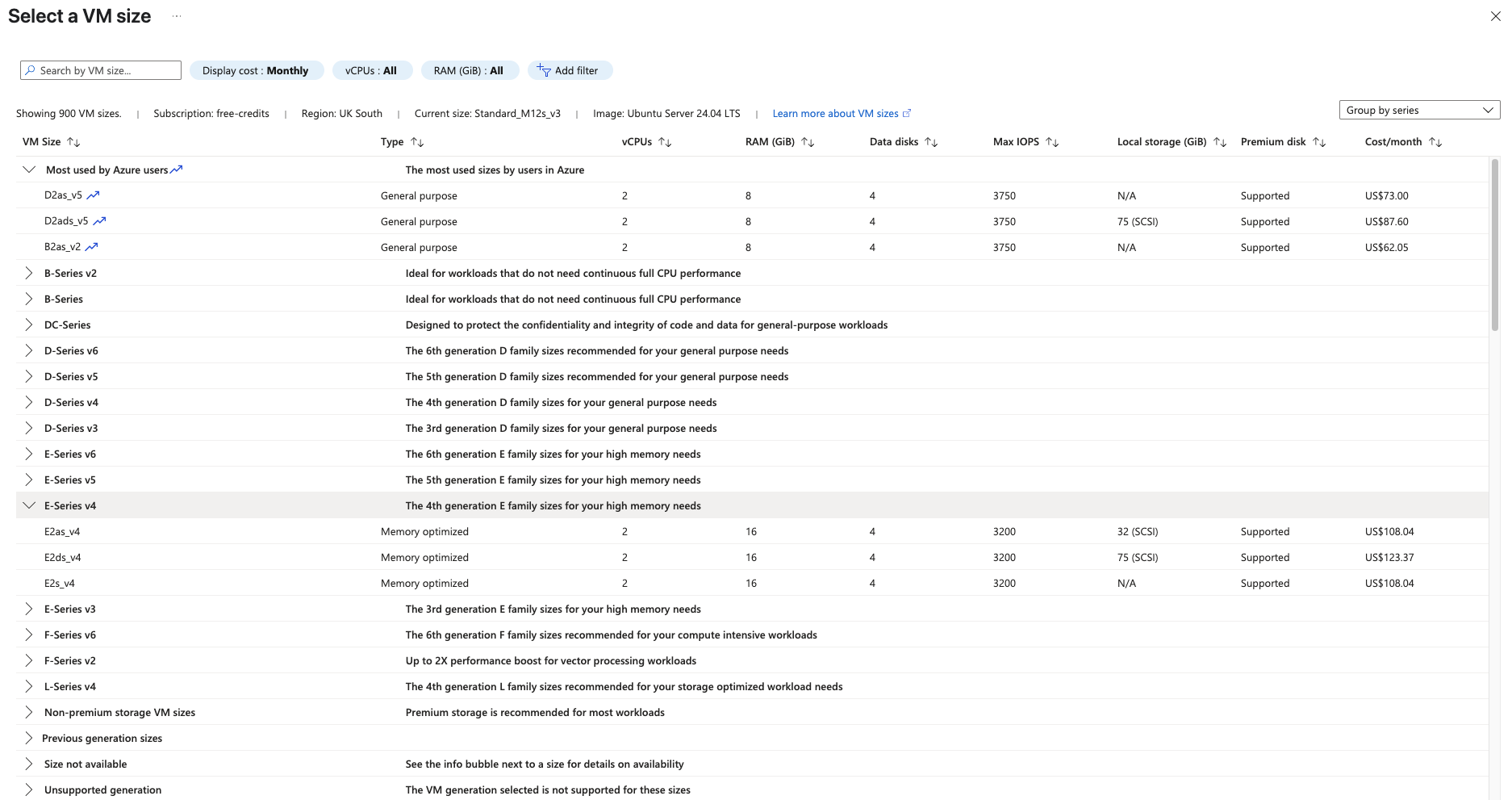Azure offers a wide variety of virtual machine sizes and series, each optimized for different types of workloads. Understanding these options will help you choose the right VM for your research needs while managing costs effectively.
Many of the series below will not be appropriate to researchers needs, however for clarity we've included them all. The following information can be found with more detail here.
⚠️ Free Subscription Limitations
Important: Many of the higher-end VM series (marked with 🔒) are not available on Azure's free subscription tier. If you need access to these powerful instances for your research, contact your university or institute for access to their institutional Azure tenant, which typically has higher quotas and access to premium VM sizes.
Azure Virtual Machine Series Overview
| Series | Category | Description | Best For | Starting Price* |
|---|---|---|---|---|
| A-Series | Entry | Entry-level VMs for development and testing with basic CPU performance | Development, testing, code repositories | ~£8/month |
| B-Series | Burstable | Economical burstable VMs that can burst to higher CPU when needed | Low-traffic web servers, development environments | ~£3/month |
| D-Series | General | Balanced compute, memory, and storage for production workloads | Web applications, enterprise apps, databases | ~£30/month |
| E-Series | Memory | High memory-to-core ratio optimized for memory-intensive applications | Large databases, in-memory analytics, SAP HANA | ~£45/month |
| F-Series | Compute | High CPU-to-memory ratio for compute-intensive workloads | Batch processing, web servers, analytics, gaming | ~£25/month |
| G-Series 🔒 | Memory | Large memory and storage configurations with Intel Xeon E5 v3 | Large SQL/NoSQL databases, ERP, data warehousing | ~£200/month |
| H-Series 🔒 | HPC | High-performance computing with fastest CPU and optional InfiniBand | Fluid dynamics, finite element analysis, simulation | ~£400/month |
| L-Series | Storage | Storage optimized with high throughput and low latency local storage | NoSQL databases (Cassandra, MongoDB), data warehousing | ~£300/month |
| M-Series 🔒 | Memory | Massive memory configurations up to 4TB RAM for largest workloads | SAP HANA, large in-memory databases | ~£800/month |
| Mv2-Series 🔒 | Memory | Largest memory VMs with up to 12TB RAM and 416 vCPUs | Largest in-memory databases, massive parallel processing | ~£12,000/month |
| N-Series 🔒 | GPU | GPU-enabled VMs with NVIDIA Tesla GPUs for AI and graphics workloads | Deep learning, AI/ML training, graphics rendering | ~£500/month |
💡 Pricing Notes
*Starting prices are approximate and based on the smallest instance in each series for Linux VMs in UK regions. Actual pricing varies by region, operating system, and specific VM size. Windows VMs typically cost 10-15% more. Use the Azure Pricing Calculator for precise estimates.
Finding Available VM Sizes
When creating a virtual machine in Azure, you'll be able to see all available VM sizes by clicking the "See all sizes" link under the Sizes box in the VM creation portal.

The interface shows detailed specifications including vCPUs, RAM, storage, and pricing. There is also sections dedicated to those that aren't available to you, given quota, region, or image type.

Choosing the Right VM Series for Research
As a researcher, your choice of VM series should align with your specific computational needs:
- Starting out: Begin with B-Series or D-Series for general research tasks and development
- Data analysis: Consider E-Series for large datasets that require substantial memory
- Machine learning: N-Series GPU instances for training models (requires institutional access)
- High-performance computing: H-Series for complex simulations and modeling
- Big data processing: L-Series for applications requiring fast local storage